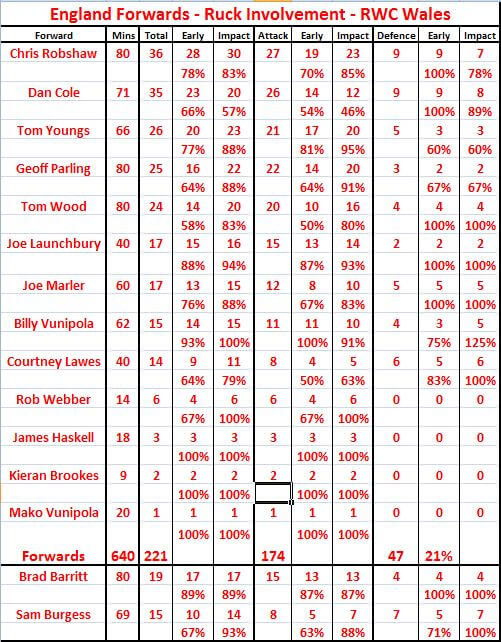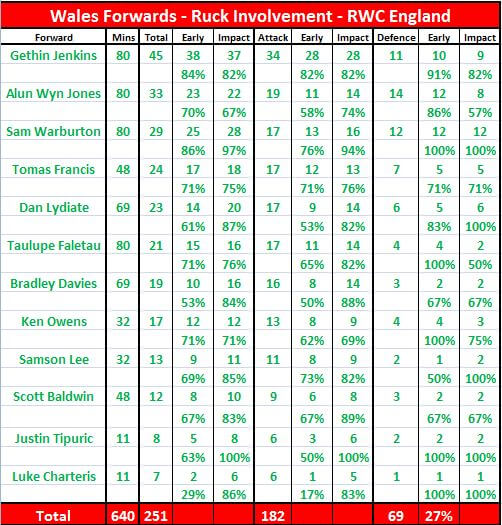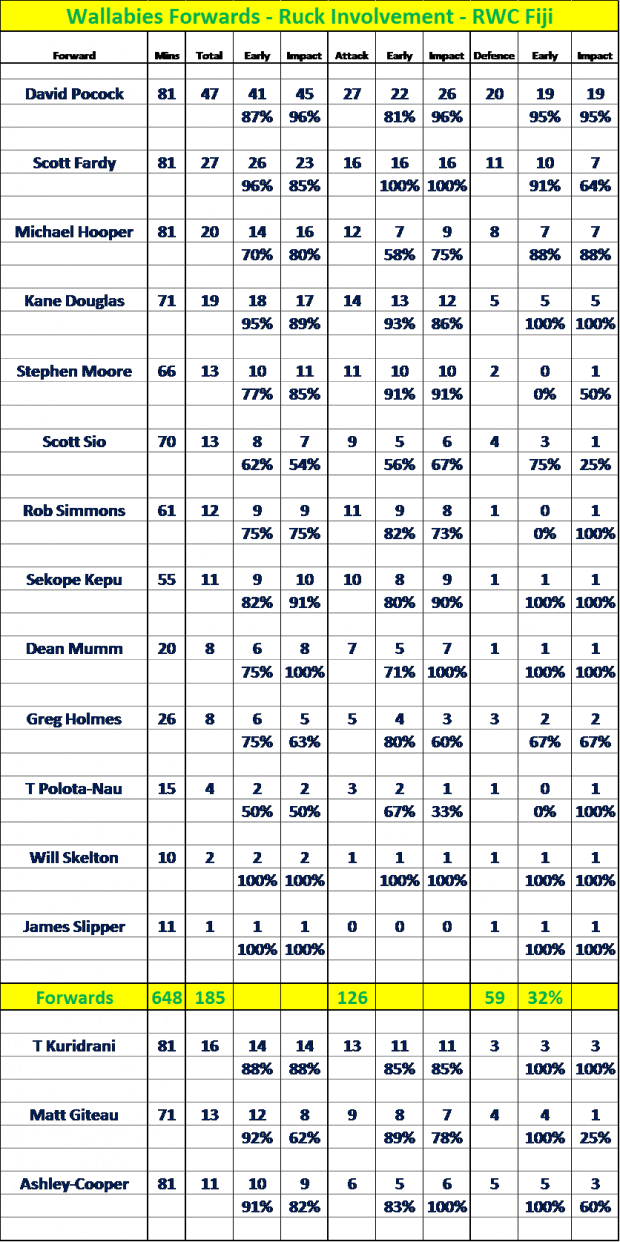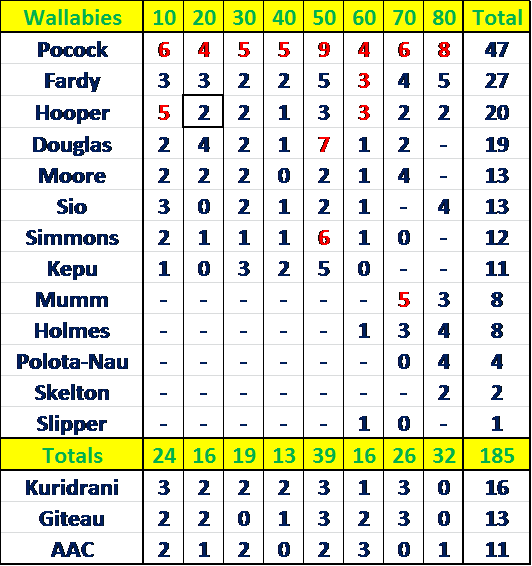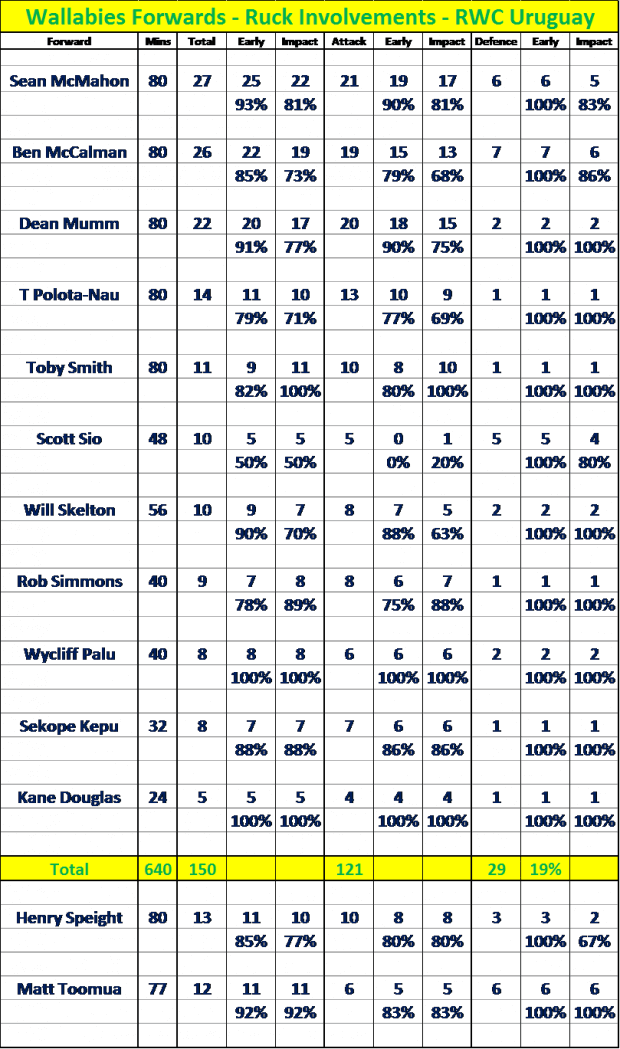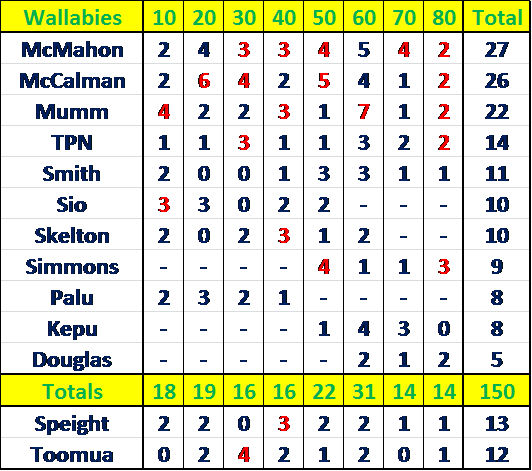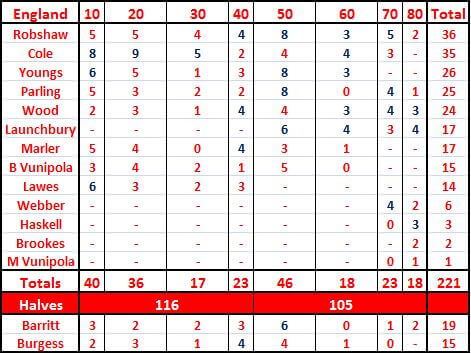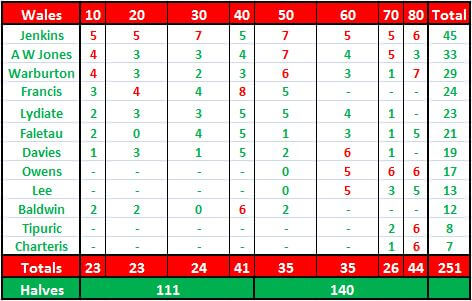England v Wales Forwards – RWC Ruck Involvement
The recent RWC Test between England and Wales was a closely fought battle.
Not only was the scoreboard tight (England 25:28 Wales) but almost all key statistics were extremely close. Yet the half-time scoreline was England 16:9 Wales. It was a memorable comeback by Wales.
England ran the ball more (468m v 387m), had more Territory (53%) and marginally more Possession.
Both teams scored a single Try. Owen Farrell kicked 6 from 6 shots on goal plus a field goal. Dan Biggar kicked 8 from 8 shots on goal but missed a field goal attempt.
All-in-all it was a bit like the attrition of trench warfare between two evenly matched opponents.
Australia plays both these sides over the next two weeks.
I’ve collected the Ruck Involvement data for this game and there’s a bit to be learned for the Wallabies. If nothing else it shows who does most of the ruck work for these two opponents.
As per usual – remember:
- Early means 1st or 2nd of player’s team AFTER the ball carrier has been tackled and brought to ground.
- Impact means active engagement: strong physical contact, changed shape of ruck, clean-out, protecting ball etc. (more than hand on someone’s bum or arriving after the hard work has been done). Yes it’s subjective – but as I collect all data at least it’s consistent.
- Impact DOES NOT equate to Effectiveness. I’ve concluded that coming up with an effectiveness measure is just too hard in the time that I have available – but open to suggestions.
England Forwards Ruck Data
Wales Forwards Ruck Data
Comments
ENGLAND
- England had 274 Total Ruck Involvements (174 Attack/47 Defence).
- England Backs had 19% of Total ruck and 23% of Defensive ruck involvements.
- Barritt and Burgess had ruck involvements comparable to some Forwards.
- Defensive ruck involvement was only 22% of Total ruck involvement.
- England Front Row had 39% of Total ruck involvements made by Forwards.
- England Locks had 25% of Total ruck involvements made by Forwards.
- England Back Row had 35% Total ruck involvements made by Forwards.
- This ruck involvement split across the Forward pack is similar to that of the All Blacks and Boks.
- England earned 7 Turn Overs from 61 Defensive ruck involvements (1 TOW/9 DRI).
- Robshaw earned 2 TOW from 9 DRI (1 TOW/5 DRI) (From Vodacom App) .
WALES
- Wales had 283 Total Ruck Involvements (207 Attack/77 Defence).
- Wales Backs had only 11% of Total ruck and 9% of Defensive ruck involvements.
- No Wales Backs had ruck involvements comparable to the Forwards (Roberts 8, North 7, Liam Williams 6)
- Defensive ruck involvement was 28% of Total ruck involvement by Forwards.
- Wales Front Row had 44% of Total ruck involvements made by Forwards.
- Wales Locks had 24% of Total ruck involvements made by Forwards.
- Wales Back Row had 32% of Total ruck involvements made by Forwards.
- This is an extremely heavy ruck involvement workload by the Front Row.
- Wales earned 6 Turn Overs from 70 Defensive ruck involvements (1 TOW/12 DRI)
- Faletau earned 2 TOW from 4 DRI (1 TOW/2 DRI) (From Vodacom App) .
Wallaby Ruck stats for the Fiji Test can be viewed here:
Observations:
- Wallaby Backs had 25% of Total ruck involvements. The Wallabies are well-served at the breakdown by some consistently involved and energenic Backs.
- Defensive ruck involvement was 32% of Total ruck involvement by Forwards.
- Wallaby Front Row had 29% of Total ruck involvements by Forwards.
- Wallaby Locks had 25% of Total ruck involvements made by Forwards.
- Wallaby Back Row had 47% of Total ruck involvements made by Forwards.
- England, All Blacks and South Africa have Front Rows which contribute 35% – 40% of Total ruck involvements by Forwards.
- The Wallaby Front Row consistently contributes <30% of Total Ruck involvements.
- If this lower level of ruck involvement is combined with generally low tackle counts then the Wallaby Front Row is not contributing at the same level as other top-tier teams.
- Contribution by the Wallaby Locks is about average for these top-tier teams.
- The Wallaby Back Row is generally making 10%-15% more of the Total ruck involvements compared to other top-tier Back Rows.
- The Wallabies earned 10 Turn Overs from 79 Defensive ruck involvements (1 TOW/8 DRI).
- Pocock earned 5 TOW from 20 DRI (1 TOW/4 DRI) (From Vodacom APP)
Wallaby Ruck stats for the Uruguay Test can be viewed here:
Wales v England 10-Minute Comparisons
Comments:
ENGLAND
- Robshaw and Cole show work rates/ruck involvements significantly above their team mates.
- Cole very much the spectator when involved in supporting the England ball carriers. He generally arrives late and has minimal impact.
- Launchbury had good ruck involvement after replacing Lawes at half-time.
- The England Forwards work rate/involvement lifted significantly for the first 10 minutes after half-time but this level could not be sustained. Total ruck involvements actually reduced in the second half when Wales fought back. Is fitness an issue? If so then it’s unlikely to be corrected in 7 days.
WALES
- Gethin Jenkins, the 34yo, 122 Test veteran was the work horse at the ruck against England with a performance 36% above the next best for ruck involvements. His wrokrate was fairly even over the full 80 minutes. IMPRESSIVE!
- A W Jones and Warburton were at the next level with significant involvement in Defensive rucks.
- Wales Forwards lifted their work rate/involvement in the 2nd half (+27%) and effectively outmuscled the opposition.
- Wales Bench players were significant contributors to this improved ruck performance.
WALLABY COMPARISON (Fiji)
- Pocock was the major contributor with ruck involvement 74% higher than the next.
- Fardy was 35% higher than the next grouping.
- Hooper and Douglas were >50% above the next grouping.
- These 4 players had 75% of the Defensive ruck involvements of the Wallaby Forwards.
- Against Fiji, the Wallabies also lifted their work rate/intensity in the second half with 57% more ruck involvements. (Against Uruguay, the extended squad also lifted their ruck involvements by 17% in the 2nd)
In short, what does it mean?
I believe that fitness may well be a telling factor against England on 4 October.
This combined with a more expansive game, and the ability to score tries, should ensure a win – even at Twickenham.


